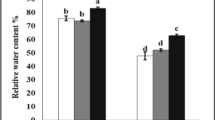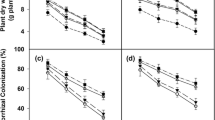Abstract
Salinity, a serious environmental pressure on crop production, might be counteracted by free-living and symbiotic inoculants entailing positive synergistic effects. Enhancement in nutrient uptake and/or production of antioxidants under the stress condition, can improve plant growth and yield. In this study, inoculation of Lallemantia iberica with Funneliformis mosseae and the sulfur solubilizing bacterium (Thiobacillus sp. T95 and T40) was evaluated under two salinity levels (6.72 dS/m and 0.91 dS/m as control). The root colonization, spore density, seed and biological yield, total soluble sugars, and nutrients were reduced by salt stress. Antioxidant enzyme activity (catalase, superoxide dismutase, peroxidase and ascorbate peroxidase), proline, contents of sodium and sulfur have increased under salt stress. The enzyme activities as well as the concentrations of nitrogen, phosphorus, potassium, sodium, and sulfur were dropped at the flowering stage (75 days after sowing). Seed and biological yield, antioxidant enzymes activity, proline content, and nutrients were significantly improved in mycorrhizal treatments. Inoculation of Thiobacillus exhibited the positive effect on root colonization, spore density, enzymes activity, and nutrients. Bacterial treatments (dual and single) significantly increased the sulfur and total soluble sugars. Totally, the mycorrhizal plants accumulated more enzymatically produced antioxidants, osmolytes, and showed improved nutrient uptake. Our results provide new insights into the relationship among arbuscular mycorrhizal fungi (AMF), biosulfur bacteria, and plant growth under saline conditions. In conclusion, the Lallemantia iberica inoculation with mycorrhizal fungi, either alone, or in combination with Thiobacillus, is indicated for optimum plant yield through alleviation of the salinity stress.





Similar content being viewed by others
Abbreviations
- AMF:
-
Arbuscular mycorrhizal fungi
- POX:
-
Peroxidase
- APX:
-
Ascorbate peroxidase
- ROS:
-
Reactive oxygen species
- CAT:
-
Catalase
- SOD:
-
Superoxide dismutase
- DARI:
-
Dryland Agricultural Research Institute
- TSS:
-
Total soluble sugars
- DAS:
-
Days after sowing
- WUE:
-
Water use efficiency
- GR:
-
Glutathione reductase
References
Fathi M, Emam-Djomeh Z, Sadeghi-Varkani A (2018) Extraction, characterization and rheological study of the purified polysaccharide from Lallemantia ibrica seeds. Int J Biol Macromol 120:1265–1274. https://doi.org/10.1016/j.ijbiomac.2018.08.159
Amanzadeh Y, Khosravi Dehagni N, Gohari AR, Monsef-Esfehani HR, Sadat Ebrahimi SE (2011) Antioxidant activity of essential oil of Lallemantia iberica in flowering stage and post-flowering stage. Res J Biol Sci 6:114–117. https://doi.org/10.3923/rjbsci.2011.114.117
Awad A, Barta SL, Fink CS, Bradford PG (2008) β-sitosterol enhances tamoxifen effectiveness on breast cancer cells by affecting ceramide metabolism. Mol Nutr Food Res 52:419–426. https://doi.org/10.1002/mnfr.200700222
Munns R, Tester M (2008) Mechanisms of salinity tolerance. Annu Rev Plant Biol 59:651–681. https://doi.org/10.1146/annurev.arplant.59.032607.09
Samadi S, Khaiyamiand M, Hasanzadeh A (2007) A Comparison of important physical and chemical characteristics of six Lallemantia iberica (Bieb.) varieties. Pak J Nutr 6:387–390
Yadegari M (2014) Study of ratio and speed germination of twelve medicinal plants under several treatments of salinity. Adv Environ Biol 8:425–430
Foyer CH (2018) Reactive oxygen species, oxidative signaling and the regulation of photosynthesis. Environ Exp Bot 154:134–142. https://doi.org/10.1016/j.envexpbot.2018.05.003
Rahimzadeh S, Pirzad A (2017) Arbuscular mycorrhizal fungi and Pseudomonas in reduce drought stress damage in flax (Linum usitatissimum L.): a field study. Mycorrhiza 27:537–552. https://doi.org/10.1007/s00572-017-0775-y
Mohamed AA, Eweda WEE, Heggo AM, Hassan EA (2014) Effect of dual inoculation with arbuscular mycorrhizal fungi and sulphur-oxidising bacteria on onion (Allium cepa L.) and maize (Zea mays L.) grown in sandy soil under greenhouse conditions. Ann Agric Sci 59:109–118. https://doi.org/10.1016/j.aoas.2014.06.015
Pirzad A, Mohammadzadeh S (2018) Water use efficiency of three mycorrhizal Lamiaceae species (Lavandula officinalis, Rosmarinus officinalis and Thymus vulgaris). Agric Water Manag 204:1–10. https://doi.org/10.1016/j.agwat.2018.03.020
Hanin M, Ebel C, Ngom M, Laplaze L, Masmoudi K (2016) New insights on plant salt tolerance mechanisms and their potential use for breeding. Front Plant Sci 7:1664–1462. https://doi.org/10.3389/fpls.2016.01787
Pokorna D, Zabranska J (2015) Sulfur-oxidizing bacteria in environmental technology. Biotechnol Adv 33:1246–1259. https://doi.org/10.1016/j.biotechadv.2015.02.007
Wang YF, Wang SP, Cui XY, Chen ZZ, Schnug E, Haneklau S (2003) Effects of sulphur supply on the morphology of shoots and roots of alfalfa (Medicago sativa L.). Grass Forage Sci 58:160–167. https://doi.org/10.1046/j.1365-2494.2003.00366.x
Garcia Júnior O (1992) O enxofre e suas transformações microbianas. In: Tsai SM, Neves MCP (eds) Cardoso EJB. Microbio-logia do solo, Sociedade Brasileira de Ciência do Solo Campinas, pp 1–15
Mostafavin SR, Pirdashti H, Ramaznpour MR, Andarkhoran AA, Shahsavari A (2008) Effect of mycorrhizal, Thiobacillus and sulfur nutrition on the chemical composition of Soybean (Glycine max L.) Merr Seed. Pak J Biol Sci 11:826–835. https://doi.org/10.3923/pjbs.2008.826.835
Issam IB, Antoin HS (2007) Methods of analysis for soils of arid and semi-arid regions. Food and Agriculture organization of the United Nations, Rome
Øvreås L, Torsvik V (1998) Microbial diversity and community structure in two different agricultural soil communities. Microb Ecol 36:303–315. https://doi.org/10.1007/s002489900117
Soil Survey Staff (2014) Keys to soil taxonomy, 12th edn. USDA, NRCS, Washington
Phillips JM, Hayman DS (1970) Improved procedures for clearing roots and staining parasitic and vesicular arbuscular mycorrhizal fungi for rapid assessment of infection. Trans Br Mycol Soc 55:158–161. https://doi.org/10.1016/s0007-1536(70)80110-3
McGonigle TP, Miller MH, Evans DG, Fairchild DL, Swan GA (1990) A new method which gives an objective measure of colonisation of roots by vesicular arbuscular mycorrhizal fungi. New Phytol 115:495–501. https://doi.org/10.1111/j.1469-8137.1990.tb00476.x
Gerdemann JW, Nicolson TH (1963) Spores of mycorrhizal Endogone species extracted from soil by wet sieving and decanting. Trans Br Mycol Soc 46:235–244. https://doi.org/10.1016/S0007-1536(63)80079-0
McGill WB, Figueiredo CT (1993) Total nitrogen. In: Carter MR (ed) Soil sampling and methods of analysis, society of soil science. Lewis, Boca Raton, pp 201–211
Waling I, Vark WV, Houba G, Van der Lee JJ (1989) Soil and plant analysis, a series of syllabi. Part 7. Plant Anal Proced. Wageningen Agriculture University, Wageningen
Chapman HD, Pratt PF (1962) Methods of analysis for soils, plants and waters. Soil Sci 93:68. https://doi.org/10.1097/00010694-196201000-00015
Tabatabai MA, Bremner JM (1970) A simple turbidimetric method of determining total sulfur in plant material. Agron J 62:805–806. https://doi.org/10.2134/agronj1970.00021962006200060038x
Bradford MM (1976) A rapid and sensitive method for the quantitation of microgram quantities of protein utilizing the principle of protein-dye binding. Ann Biochem 72:248–254. https://doi.org/10.1016/0003-2697(76)90527-3
Beauchamp C, Fridovich I (1971) Superoxide dismutase: improved assays and an assay applicable to acrylamide gels. Anal Biochem 44:276–287. https://doi.org/10.1016/0003-2697(71)90370-8
Nakano Y, Asada K (1981) Hydrogen peroxide is scavenged by ascorbate-specific peroxidase in spinach chloroplasts. Plant Cell Physiol 22:867–880. https://doi.org/10.1093/oxfordjournals.pcp.a076232
MacAdam JW, Nelson CJ, Sharp RE (1992) Peroxidase activity in the leaf elongation zone of tall fescue: I. spatial distribution of ionically bound peroxidase activity in genotypes differing in length of the elongation zone. Plant Physiol 99:872–878. https://doi.org/10.1104/pp.99.3.872
Dhindsa RH, Plumb-Dhindsa R, Thorpe TA (1981) Leaf senescence correlated with increased level of membrane permeability, lipid peroxidation and decreased level of SOD and CAT. J Exp Bot 32:93–101. https://doi.org/10.1093/jxb/32.1.93
Bates LS, Waldren RP, Teare ID (1973) Rapid determination of free proline for water-stress studies. Plant Soil 39:205–207. https://doi.org/10.1007/bf00018060
Irigoyen JJ, Einerich DW, Sanchez-Diaz M (1992) Water stress induced changes in concentrations of proline and total soluble sugars in nodulated alfalfa (Medicago sativd) plants. Physiol Plant 84:55–60. https://doi.org/10.1111/j.1399-3054.1992.tb08764.x
Bothe H (2012) Arbuscular mycorrhiza and salt tolerance of plants. Symbiosis 58:7–16. https://doi.org/10.1007/s13199-012-0196-9
Hajiboland R, Aliasgharzadeh A, Laiegh SF, Poschenrieder C (2010) Colonization with arbuscular mycorrhizal fungi improves salinity tolerance of tomato (Solanum lycopersicum L.) plants. Plant Soil 331:313–327. https://doi.org/10.1007/s11104-009-0255-z
ŘezáčováV SR, Sochorová L, Konvalinková T, ProcházkováV ŠV, Hršelová H, Beskid O, Hujslová M, Gryndlerová H, Gryndler M, Püschel D, Jansa J (2018) Mycorrhizal symbiosis induces plant carbon re-allocation differently in C3 and C4 Panicum grasses. Plant Soil 425:441–456. https://doi.org/10.1007/s11104-018-3606-9
Johnson CR, Graham JH, Leonard RT, Menge JA (1982) Effect of flower bud development in chrysanthemum on vesicular-arbuscular mycorrhiza formation. New Phytol 90:671–675. https://doi.org/10.1111/j.1469-8137.1982.tb03277.x
Malagoli P (2005) Dynamics of nitrogen uptake and mobilization in field-grown winter oilseed rape (Brassica napus) from stem extension to harvest: I. Global N flows between vegetative and reproductive tissues in relation to leaf fall and their residual N. Ann Bot 95:853–861. https://doi.org/10.1093/aob/mci091
Rais L, Masood A (2013) Sulfur and nitrogen co-ordinately improve photosynthetic efficiency, growth and proline accumulation in two cultivars of mustard under salt stress. J Plant Biochem Physiol 1:1–6. https://doi.org/10.4172/jpbp.1000101
Miransari M (2013) Arbuscular mycorrhizal fungi and uptake of nutrients. Symbiotic Endophytes. Springer, Berlin, pp 253–270
Dominguez-Nuñez JA, Benito B, Berrocal-Lobo M, Albanesi A (2016) Mycorrhizal fungi: role in the solubilization of potassium. In: Meena V, Maurya B, Verma J, Meena R (eds) Potassium Solubilizing Microorganisms for Sustainable Agriculture. Springer, New Delhi, pp 77–98
Ahmad H, Hayat S, Ali M, Liu T, Cheng Z (2018) The combination of arbuscular mycorrhizal fungi inoculation (Glomus versiforme) and 28-homobrassinolide spraying intervals improves growth by enhancing photosynthesis, nutrient absorption, and antioxidant system in cucumber (Cucumis sativus L.) under salinity. Ecol Evol 8:5724–5740. https://doi.org/10.1002/ece3.4112
Evelin H, Kapoor R (2013) Arbuscular mycorrhizal symbiosis modulates antioxidant response in salt-stressed Trigonella foenum-graecum plants. Mycorrhiza 24:197–208. https://doi.org/10.1007/s00572-013-0529-4
Rodriguez-Amaya DB (2003) Food carotenoids: analysis, composition and alterations during storage and processing of foods. Forum Nutr 56:35–37
Wang SV, Jiao H (2001) Changes in oxygen-scavenging systems and membrane lipid peroxidation during maturation and ripening in black berry. J Agric Food Chem 49:1612–1619. https://doi.org/10.1021/jf0013757
Bharti N, Barnawal D (2019) Amelioration of salinity stress by PGPR: ACC deaminase and ROS scavenging enzymes activity (Chap. V)). In: Kishore Singh A, Kumar A, Kumar Singh P (eds) PGPR Amelioration in Sustainable Agriculture. Charlotte Cockle Publisher, Chennai, pp 85–106
Lei P, Xu Z, Liang J, Luo X, Zhang Y, Feng X, Xu H (2016) Poly (γ-glutamic acid) enhanced tolerance to salt stress by promoting proline accumulation in Brassica napus L. Plant Growth Regul 78:233–241. https://doi.org/10.1007/s10725-015-0088-0
Kohler J, Hernández JA, Caravaca F, Roldán A (2009) Induction of antioxidant enzymes is involved in the greater effectiveness of a PGPR versus AM fungi with respect to increasing the tolerance of lettuce to severe salt stress. Environ Exp Bot 65:245–252. https://doi.org/10.1016/j.envexpbot.2008.09.008
Bakry AB, Mervat SS, El-karamany MF (2015) Effect of humic acid and sulfur on growth, some biochemical constituents, yield and yield attributes of flax grown under newly reclaimed sandy soils. ARPN J Agric Biol Sci 10:247–259
Lewis JD, Wang XZ, Griffin KL, Tissue DT (2002) Effects of age and ontogeny on photosynthetic responses of a determinate annual plant to elevated CO2 concentrations. Plant Cell Environ 25:359–368. https://doi.org/10.1046/j.0016-8025.2001.00815.x
Urban L, Jegouzo L, Damour G, Vandame M, Francois C (2008) Interpreting the decrease in leaf photosynthesis during flowering in mango. Tree Physiol 28:1025–1036. https://doi.org/10.1093/treephys/28.7.1025
Acknowledgements
We thank Dr. Shahram Manafi, (Department of Soil Science, Urmia University) for his helps to identify soil used in the experiment.
Funding
This research received no specific grant from any funding agency in the public, commercial, or not-for-profit sectors.
Author information
Authors and Affiliations
Contributions
Shabnam Heydari is a PhD student in Urmia University, and Professor Alireza Pirzad (Corresponding author) is supervisor of her thesis.
Corresponding author
Ethics declarations
Conflict of interest
We declare that there is no conflict of interest in this manuscript with person and /or institute.
Additional information
Publisher's Note
Springer Nature remains neutral with regard to jurisdictional claims in published maps and institutional affiliations.
Electronic supplementary material
Below is the link to the electronic supplementary material.
Rights and permissions
About this article
Cite this article
Heydari, S., Pirzad, A. Mycorrhizal Fungi and Thiobacillus Co-inoculation Improve the Physiological Indices of Lallemantia iberica Under Salinity Stress. Curr Microbiol 77, 2523–2534 (2020). https://doi.org/10.1007/s00284-020-02034-y
Received:
Accepted:
Published:
Issue Date:
DOI: https://doi.org/10.1007/s00284-020-02034-y




